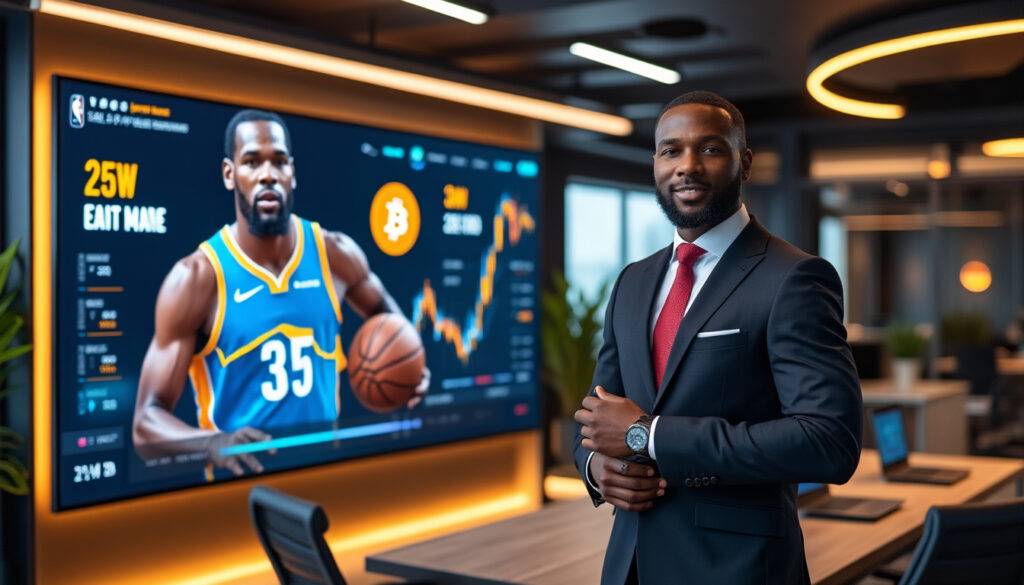Coinbase CEO Clarifies NBA Star Kevin Durant's Bitcoin Account Situation

Coinbase CEO Clarifies NBA Star Kevin Durant's Bitcoin Account Situation
In a move that blends basketball star power with crypto logistics, Coinbase CEO Brian Armstrong confirmed that Kevin Durant has regained access to a Bitcoin wallet he opened nearly a decade ago. The disclosure comes as Bitcoin stands well above the price Durant first bought in 2016, highlighting how athlete endorsements and digital wallets intersect with the blockchain era. The saga underscores both the potential and the pitfalls of crypto ownership for high-profile athletes and fans alike.
- The account recovery was completed after Durant had been unable to log in for years, a situation Armstrong publicly acknowledged on social media.
- Durant’s early crypto purchases date back to 2016, when Bitcoin traded around $650 per coin, setting the stage for a multi-year growth story.
- Durant’s relationship with Coinbase extends beyond a single wallet, involving his 35V investment firm and a later athlete endorsement role.
- The recovery highlights Coinbase’s role as a major crypto exchange and digital wallet provider within the broader blockchain ecosystem.
- The development offers a concrete case study for athletes considering long-term crypto holdings and the importance of account security.
Key Takeaways For Crypto, Sports, And Digital Wallet Management
The Durant episode is more than a personal win; it reflects how a major exchange interacts with high-profile users and their historical crypto positions. For athletes and fans, the incident provides a blueprint—and a warning—for securing digital wallet access, managing legacy holdings, and navigating public endorsements in the era of cryptocurrency.
From 2016 Bitcoin Buys To A Multi-Million Dollar Stack: Durant’s Crypto Tale Expands
Durant first dipped into Bitcoin toward the end of 2016, a period when the digital asset traded around the $650 mark. Fast forward to 2025, and the same asset sits near six-figure territory, turning modest bets into multimillion-dollar holdings for those who held through the volatility. This trajectory isn’t just a numbers story—it’s a reminder of how cryptocurrency ownership can accumulate wealth over time, even when access to the wallet is intermittently delayed.
- Bitcoin’s price appreciation since 2016 translates a hypothetical $10,000 purchase into a roughly $1.8 million stake by 2025, illustrating the long-game potential of early crypto bets.
- Even a single 2016 Bitcoin purchased by Durant would be worth well over $100,000 today, underscoring the scale of the asset’s growth for patient investors.
- Durant’s involvement with Coinbase extended beyond personal accounts, spanning investment and ambassador roles that integrate sports branding with crypto education.
- Access issues from the pre-ambassador era highlight the importance of secure, recoverable credentials in the digital wallet era.
- The Durant story emphasizes how athletes and teams are increasingly seen as athlete endorsement conduits for mainstream crypto adoption.
Armstrong’s Public Recovery Message And The Broader Crypto-Industry Context
The public recovery patch comes after a period of silence on the accessibility of nearly decade-old holdings. Armstrong’s confirmation—“We got this fixed. Account recovery complete!”—placed a spotlight on Coinbase’s customer-service capabilities and the security measures that govern long-dormant assets. For fans and investors, the moment blends a high-profile endorsement with a practical lesson about safeguarding assets on a platform at the heart of today’s cryptocurrency ecosystem.
- The recovery underscores Coinbase’s status as a leading crypto exchange and a guardian of user assets on the blockchain.
- Durant’s ongoing relationship with Coinbase—dating back to 2017 with the 35V fund and later ambassadorial work—illustrates a fusion of professional sports branding and crypto literacy.
- The numbers around the saga illustrate the power of crypto wealth: even moderate early investments can compound dramatically over a decade.
- As the crypto market matures, public recoveries like this affect investor confidence and the perception of crypto as a long-term store of value.
- The case fuels ongoing debates about athlete endorsements and the responsibility that comes with promoting complex financial assets.
Why This Matters For Fans, Investors, And The NBA
For fans watching from the stands, the Durant recovery is more than a feel-good story. It demonstrates how a player’s brand intersects with a dynamic tech sector, shaping perceptions around blockchain, digital wallet security, and the viability of athlete endorsements in the crypto era. The evolving partnership between the NBA, Durant’s influence, and Coinbase signals a broader trend toward mainstream acceptance of Bitcoin and other digital assets within professional sports.
FAQ
- What happened with Kevin Durant’s Coinbase account?
Coinbase CEO Brian Armstrong confirmed that Durant regained access to a wallet opened nearly 10 years ago after years of login problems, marking a successful account recovery. - How much could Durant's early Bitcoin investments be worth now?
If he bought Bitcoin in 2016 around $650 and held through 2025, even modest sums could be worth millions, illustrating the extraordinary gains possible with long-term crypto holds. - What does this say about athlete endorsements and crypto?
It shows the growing willingness of athletes and major brands to collaborate in the crypto space, while underscoring the need for solid security and clear disclosure around asset ownership. - Should fans consider owning cryptocurrency when following NBA players?
Fans should approach crypto with education, diversify risk, and treat digital wallets as valuable, recoverable assets—especially when public figures are involved in endorsements.

